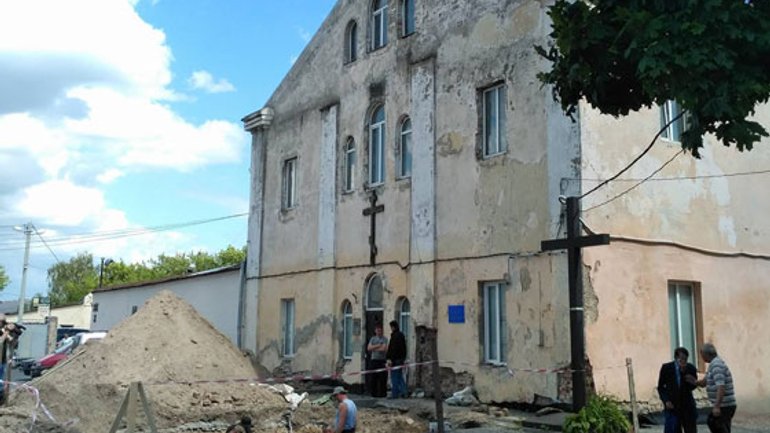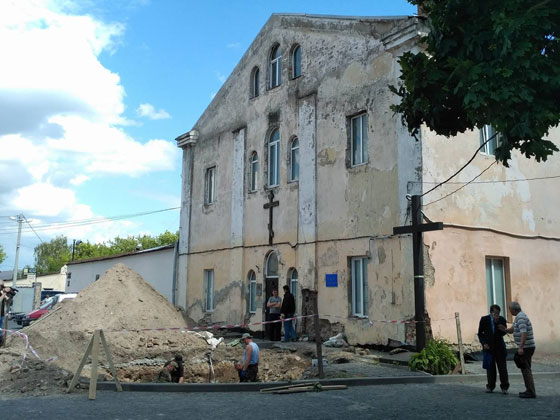Mass graves of NKVD victims found in Lutsk

Near the Castle of St. Michael the Archangel’s Monastery UOC-KP, in the area of Stary Lutsk Reserve on June 13, a mass grave of victims of the shootings of June 23-24, 1941 was exhumated. All these people - Lutsk prison inmates, mostly political, were suspected of having links with the OUN, former priests, teachers and doctors and intellectuals. According to preliminary data, in the first days after the attack of Nazi Germany on the Soviet Union, about 2,000 people were executed. Later these events were called a tragedy of Lutsk prison. It was reported by RISU correspondent Larysa Andriychuk.
Near the Castle of St. Michael the Archangel’s Monastery UOC-KP, in the area of Stary Lutsk Reserve on June 13, a mass grave of victims of the shootings of June 23-24, 1941 was exhumated. All these people - Lutsk prison inmates, mostly political, were suspected of having links with the OUN, former priests, teachers and doctors and intellectuals. According to preliminary data, in the first days after the attack of Nazi Germany on the Soviet Union, about 2,000 people were executed. Later these events were called a tragedy of Lutsk prison. It was reported by RISU correspondent Larysa Andriychuk.

Ethnographer Serhiy Godlevskiy who explores the subject since his student years, initiated the search for the mass grave in 2009. “The execution of prisoners, of course, was known, so in 1989 the progressive public of Lutsk started honoring the memory of the victims. The first serious research began in the 90s, the initiative group was set up, which opened a criminal case on the shooting of prisoners. Unfortunately, the case was closed, but in 2009 the search works began. It was a matter of chance. Installing rods, a local resident found human bones. It turned out that these were not prisoners, but reburied Soviet prisoners of war. The central courtyard was also searched, but only a few phalanges were found - so most of the remains were removed. Since the beginning of work on landscaping, Lutsk city council met the wishes of local historians and allocated funds for search works.”
“Despite the fact that the event is extremely sad, I have a certain sense of comfort. Finally, these people will find eternal rest and will be reburied with dignity,” Serhiy Godlevskiy said.
Archaeological work is just beginning, so now to say how many people are in a mass grave for sure impossible. However Archeology provides an opportunity to set this number exactly. The pit in which people are buried - Vyrva of stokilohramovoyi bomb. The bodies are chaotic, one on one, top - burned their case because the remains of burnt documents. Also zinc shells of ammunition for rifles Mosin shells and other Soviet-1933-34 years, which coincides with dates of executions. "All the exhumed remains will be carried out forensic examination. Judging by the condition of teeth, all people - young, obviously, not older than 40 years. Now you can only see the tip of the iceberg, because very deep burial ", - said Sergey Godlevskiy.
The works are carried out by the communal enterprise “Dolya” of Lviv regional council. Its head is Sviatoslav Sheremet, who is also executive secretary of the State Interagency Commission for perpetuating the memory of victims of war, political repression and ATO. All permits and funding were provided by Lutsk City Council.
At the central courtyard of the monastery there are plaques with the names of those shot. It was believed that this is where the bodies of those executed rest. Therefore, another page in the history of terrible crimes of Soviet power has been turned today.
The premises of St. Michael the Archangel Monastery - an architectural monument of national importance. It has an extraordinary history that goes back to early XVII century. In 1624, Lutsk mayor and Lithuanian chancellor Stanislaw Albrecht Radziwill gave the Catholic orders of St Brigida his palace attached to the wall of Okolny (lower) Lutsk Castle. In 1845, the convent set on fire, which spread to other buildings. The nuns did not allow people to the monastery to extinguish it. Compensation for losses become the confiscation of the rooms.
In 1890, the police and prison administration were arranged in the former monastery and the third floor was added. The architectural complex of Lutsk St Brigida sisters lost its shape forever. By 1960, the premises served as a prison. Further, the Lutsk State Music School was located, which operated here until 1998. Since the monastery occupied only part of the premises in October 2016, the first director of the historical and cultural reserve “Old Town” Pavlo Rudetskyy became the author of the initiative to establish the hostel here. However, the idea of the city council did not find support.









